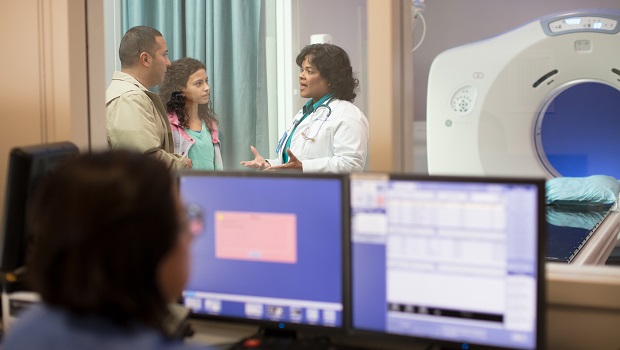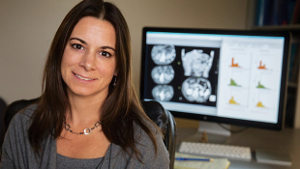Medical imaging rates keep rising despite push to reduce them

Potential harms should be considered before scanning, conclude UC and Kaiser Permanente researchers
Despite a broad campaign among physician groups to reduce the amount of imaging in medicine, the rates of use of computed tomography (CT), magnetic resonance imaging (MRI), and other scans have continued to increase in both the United States and Ontario, Canada, according to a new study of more than 135 million imaging exams conducted by researchers at the University of California (UC) Davis, UC San Francisco, and Kaiser Permanente. A recent reacceleration in the growth of imaging concerns researchers because it is widely believed to be overused.
The Journal of the American Medical Association published Trends in Use of Medical Imaging in U.S. Healthcare Systems and in Ontario, Canada, 2000-2016. This is the first study of its size to determine imaging rates across different populations. It found that although the growth in imaging slowed in the early 2000s, it ticked back up in recent years for CT and MRI in most patient age groups. A notable exception was a decline in CT use in children in recent years.
Senior author Diana Miglioretti, PhD, a senior investigator at Kaiser Permanente Washington Health Research Institute (KPWHRI) and biostatistics professor at UC Davis Department of Public Health Sciences, says there were some hopeful signs among the findings.
“The good news is that rates of CT imaging are starting to come down in children,” Dr. Miglioretti says. “But they’re still far lower in Ontario than in the United States, suggesting there is additional room for improvement. It’s also important to reduce unnecessary imaging in adults given they are also at risk of radiation-induced cancers.”
CT scans deliver ionizing radiation
Although it is widely believed that imaging rates are declining due to payment and educational efforts that have targeted unnecessary imaging, the authors found a reacceleration in imaging use, with ongoing growth in the use of CT and MRI in adults.
CT scans use ionizing radiation to create images of the inside of the body, and they deliver a radiation dose far higher than a conventional X-ray, while MRIs use magnetic fields and radio waves to create images and, like ultrasounds, do not expose patients to ionizing radiation. The authors noted that the study does not address whether the documented imaging use was appropriate or associated with better patient outcomes.
“Medical imaging is an important part of health care and contributes to accurate disease diagnosis and treatment,” says lead author Rebecca Smith-Bindman, MD, a UCSF professor of radiology, epidemiology and biostatistics, and obstetrics and reproductive medicine and a member of the Philip R. Lee Institute of Health Policy Studies. “But it also can lead to patient harms such as incidental findings, overdiagnosis, anxiety and radiation exposure that is associated with an increased risk of cancer.”
Dr. Smith-Bindman added: “Like all aspects of medicine, it’s important to make sure imaging is justified, and that the potential benefits are balanced against the potential harms. These potential harms of false positive diagnoses and overdiagnoses can affect everyone who undergoes a test and thus need to be considered when imaging is used.”
The researchers analyzed patterns of medical imaging between 2000 and 2016 among a diverse group of 16-21 million adult and pediatric patients enrolled in seven U.S. health care systems and in the universal, publicly funded health care system in Ontario, Canada. For the U.S. data, they included people receiving care in both fully integrated health care systems such as Kaiser Permanente, and systems with mixed insurance including health maintenance organizations (HMOs) and preferred provider organizations (PPOs) with fee-for-service plans.
“Our capture of medical imaging utilization across seven U.S. health care systems and Ontario, Canada, over a 16-year period provides one of the most comprehensive assessments to date of imaging in children to older adults in North America,” says Marilyn Kwan, PhD, a co-author and a senior research scientist at the Kaiser Permanente Northern California Division of Research.
Among the findings
- Rates of growth from one year to the next in CT, MRI, and ultrasound were highest in earlier years (2000-2006).
- But utilization has continued to rise year over year: Between 2012 and 2016, annual growth has been 1 percent to 5 percent for most age groups and most tests in both the United States and Ontario.
- The one exception was CT use in children, which declined in the United States from 2009 to 2013 and remained stable since 2013 and declined in Ontario since 2006.
- Rates of imaging with CT and MRI are higher in the United States than in Ontario, but that gap is closing. For example, among older adults in 2016, the United States had 51 MRIs per 1,000 patients, and Ontario had 32 per 1,000 patients.
- Rates accelerated after initially dropping for most types of imaging. For example, the rate of growth in CT scans among the elderly was 9.5 percent in 2000-2005, dropped to 0.9 percent in 2006-2011—but then increased to 3 percent annual growth over the last five years.
- Imaging rates for both adults and children were higher in the mixed model versus fully integrated health care systems, but the differences were modest.
Choosing Wisely?
The authors note that the Choosing Wisely campaign has addressed potential overuse of diagnostic testing. In 2012, the American Board of Internal Medicine Foundation launched Choosing Wisely, endorsed by 85 professional medical societies. The effort urges physicians to talk with their patients about whether an imaging study is necessary, free from harm, and supported by evidence. Other initiatives, including by the federal Centers for Medicaid and Medicare Services, have created incentives to discourage overuse of imaging by reducing reimbursement rates for certain scans.
The study authors say their findings suggest that neither the financial incentives nor the campaign to reduce use of medical imaging have been entirely effective.
“Although most physicians are aware that imaging tests are frequently overused, there are not enough evidenced-based guidelines that rely on a careful consideration of the evidence, including information on benefits and harms that can inform their testing decisions,” Smith-Bindman says. “In the absence of balanced evidence, the default decision is to image.”
Drs. Miglioretti, Smith-Bindman, and Kwan’s co-authors include Erin Bowles, MPH, and Mary Kay Theis of KPWHRI; Lawrence H. Kushi, ScD, of Kaiser Permanente Northern California Division of Research; Sheila Weinmann, PhD, of Kaiser Permanente Northwest Center for Health Research; E.C. Marlow of UC Davis; Stephanie Y. Cheng, MSc, of ICES in Toronto, Canada; James R. Duncan, MD, of Washington University in St. Louis; Robert T. Greenlee, PhD, of Marshfield Clinic Research Institute; Jason D. Pole, PhD, of the Pediatric Oncology Group of Ontario; Alanna K. Rahm, PhD, of the Center for Health Research at Geisinger, in Danville, PA, and Natasha K. Stout, PhD, of the Department of Population Medicine at Harvard Medical School and Harvard Pilgrim Health Care Institute.
The National Cancer Institute grants (R01CA185687 and R50CA2111150) and ICES, funded by an annual grant from the Ontario Ministry of Health, Long-Term Care, supported this study.
About Kaiser Permanente Washington Health Research Institute
Kaiser Permanente Washington Health Research Institute (KPWHRI) improves the health and health care of Kaiser Permanente members and the public. The institute has conducted nonproprietary public-interest research on preventing, diagnosing, and treating major health problems since 1983. Government and private research grants provide our main funding. Follow KPWHRI research on Twitter, Facebook, and LinkedIn, or subscribe to our free monthly newsletter.
About Kaiser Permanente
Kaiser Permanente is committed to helping shape the future of health care. We are recognized as one of America’s leading health care providers and not-for-profit health plans. Founded in 1945, Kaiser Permanente has a mission to provide high-quality, affordable health care services and to improve the health of our members and the communities we serve. We currently serve more than 12.4 million members in eight states and the District of Columbia. Care for members and patients is focused on their total health and guided by their personal Permanente Medical Group physicians, specialists and team of caregivers. Our expert and caring medical teams are empowered and supported by industry-leading technology advances and tools for health promotion, disease prevention, state-of-the-art care delivery and world-class chronic disease management. Kaiser Permanente is dedicated to care innovations, clinical research, health education and the support of community health. For more information, go to: kp.org/share.
news item

CT scan use in pregnancy rose in US and Canada over two decades
Large, multicenter study among first to quantify exposure to ionizing radiation during pregnancy.
news item

Can standardized CT scans improve safety?
Dr. Diana Miglioretti and University of California colleagues are developing and testing a new way to lower radiation doses while still producing sharp images



